
The Canary Islands, also known informally as the Canaries, are a Spanish region, autonomous community and archipelago in the Atlantic Ocean. At their closest point to the African mainland, they are 100 kilometres west of Morocco and the Western Sahara. They are the southernmost of the autonomous communities of Spain. The islands have a population of 2.2 million people and are the most populous special territory of the European Union.

Fuerteventura is one of the Canary Islands, in the Atlantic Ocean, geographically part of Macaronesia, and politically part of Spain. It is located 97 km (60 mi) away from the coast of North Africa. The island was declared a biosphere reserve by UNESCO in 2009.

The Province of Las Palmas is a province of Spain, consisting of the eastern part of the autonomous community of the Canary Islands. Las Palmas de Gran Canaria, capital city of this province and of the island of Gran Canaria, is the largest city in the Canary Islands.

Lanzarote is a Spanish island, the easternmost of the Canary Islands in the Atlantic Ocean, 125 kilometres off the north coast of Africa and 1,000 kilometres from the Iberian Peninsula. Covering 845.94 square kilometres, Lanzarote is the fourth-largest of the islands in the archipelago. With 152,289 inhabitants at the start of 2019, it is the third most populous Canary Island, after Tenerife and Gran Canaria. Located in the centre-west of the island is Timanfaya National Park, one of its main attractions. The island was declared a biosphere reserve by UNESCO in 1993. The island's capital is Arrecife, which lies on the eastern coastline. It is the smaller main island of the Province of Las Palmas.
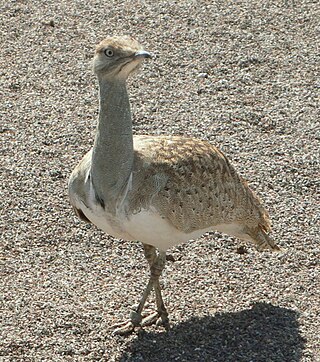
The houbara bustard, also known as African houbara, is a relatively small bustard native to North Africa, where it lives in arid habitats. The global population is listed as Vulnerable on the IUCN Red List since 2014. There is a population in the Canary Islands which has been assessed as Near Threatened in 2015.

A cabildo insular is the government and administration institution of each of the seven major islands in the Canary Islands archipelago: Tenerife, Fuerteventura, Gran Canaria, Lanzarote, La Palma, La Gomera and El Hierro. The island of La Graciosa falls under the jurisdiction of the cabildo of Lanzarote.

The Canary Islands oystercatcher, Canarian oystercatcher, or Canarian black oystercatcher , was a shorebird of uncertain taxonomy endemic to Fuerteventura, Lanzarote, and their offshore islets in the Canary Islands in Spain. It is now considered to be extinct.
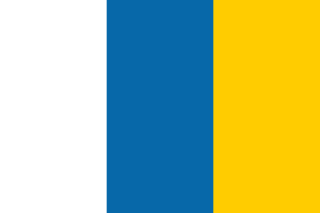
The flag of the Autonomous Community of the Canary Islands is a vertical tricolour of three equal bands of white, blue, and yellow. The state flag includes the Coat of arms of the Canary Islands in the central band; the civil flag omits this. The designs were made official by the Statute of Autonomy of the Canarian Autonomous Community on 16 August 1982.
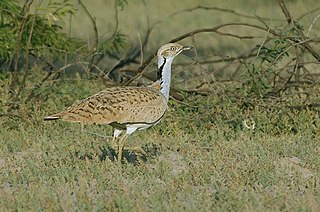
MacQueen's bustard is a large bird in the bustard family. It is native to the desert and steppe regions of Asia, west from the Sinai Peninsula extending across Kazakhstan east to Mongolia. In the 19th century, vagrants were found as far west of their range as Great Britain. Populations have decreased by 20 to 50% between 1984 and 2004 mainly due to hunting and changes in land-use. MacQueen's bustard is a partial latitudinal migrant while the houbara bustard is more sedentary. Both species are the only members of the genus Chlamydotis. MacQueen's bustard used to be regarded as a subspecies of the houbara bustard and known as the "Asian houbara".
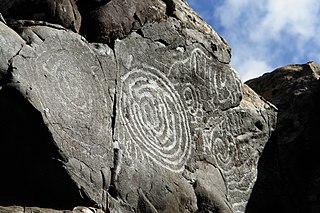
The Canary Islands have been known since antiquity. Until the Spanish colonization between 1402 and 1496, the Canaries were populated by an indigenous population, whose origin was Amazigh from North Africa.

The African blue tit is a species of bird in the family Paridae. It is found in northern Africa, Pantelleria (Italy) and the Canary Islands (Spain). Its natural habitat is temperate forests. This species and the Eurasian blue tit were formerly considered conspecific. The status of this species has not been assessed because it is noted to be common on the islands of Tenerife and Gran Canaria. The species has been used in many research studies due to its island populations and relevance to evolutionary hypotheses.
Tourism is an essential part of the economy of the Canary Islands, a Spanish archipelago located in the Atlantic Ocean, 100 kilometres west of Morocco. Seven main islands and six islets make up the Canary Islands. They had 16 million visitors in 2023. Tourists seeking sunshine and beaches first began to visit the Canaries in large numbers in the 1960s. The Canary Islands are a leading European tourist destination with very attractive natural and cultural resources.

The conquest of the Canary Islands by the Crown of Castile took place between 1402 and 1496 and described as the first instance of European settler colonialism in Africa. It can be divided into two periods: the Conquista señorial, carried out by Castilian nobility in exchange for a covenant of allegiance to the crown, and the Conquista realenga, carried out by the Spanish crown itself, during the reign of the Catholic Monarchs.

Canarian United Left is the Canarian federation of the Spanish left wing political and social movement United Left. Ramón Trujillo is the current General Coordinator. The Communist Party of the Canaries is the major member of the coalition.

The Canarian Independent Groups were a Spanish political party based in the Canary Islands that existed from 1985 until its integration in Canarian Coalition.

Fuerteventura is one of the seven constituencies represented in the Parliament of the Canary Islands, the regional legislature of the Autonomous Community of the Canary Islands. The constituency currently elects 8 deputies. Its boundaries correspond to those of the island of Fuerteventura. The electoral system uses the D'Hondt method and a closed-list proportional representation, with a minimum threshold of fifteen percent in the constituency or four percent regionally.
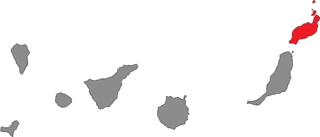
Lanzarote is one of the seven constituencies represented in the Parliament of the Canary Islands, the regional legislature of the Autonomous Community of the Canary Islands. The constituency currently elects 8 deputies. Its boundaries correspond to those of the island of Lanzarote. The electoral system uses the D'Hondt method and a closed-list proportional representation, with a minimum threshold of fifteen percent in the constituency or four percent regionally.
As in the rest of Spain, the majority religion in the Canary Islands is the Catholic Church. The Catholic religion has been the majority since the Conquest of the Canary Islands in the fifteenth century. This religion would largely replace the Canarian aboriginal religion through the prohibition of the latter and syncretism. According to a survey conducted in 2019, Canary Islands is the fifth autonomous community in Spain with the highest percentage of people who declare themselves to be Catholics after the Region of Murcia, Extremadura, Galicia, Aragon, and Castile and León. 76.7% of the population is Catholic.

The geology of the Canary Islands is dominated by volcanic rock. The Canary Islands, and some seamounts to the north-east, form the Canary Volcanic Province. The volcanic history of this province started about 70 million years ago. The Canary Islands region is still volcanically active. The most recent volcanic eruption on land occurred in 2021 and the most recent underwater eruption was in 2011-12.




















